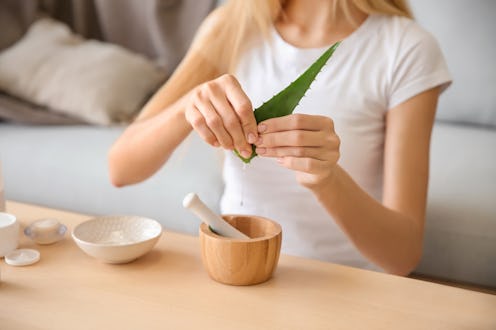Beauty
TikTok Swears By Frozen Skin Sticks For Puffiness — Here's What Derms Say
An easy DIY treatment.

TikTok loves a good beauty hack. Whether it’s using a tub of Vaseline for slugging your skin or a $4 makeup balm to add dimension to your face, there are tons of brilliant yet unexpected ways to level up your routine. And the viral trend du jour involves The Dream Skin’s Frozen Stick, a beauty tool users swear by for quashing puffiness.
The Frozen Stick (which has over 60 thousand views on the video-sharing app) is exactly what the name implies: It’s a stick made with a water base that you can infuse with different ingredients — typically stuff you can find in your fridge — before freezing it and gliding it over your skin. There are multiple variations floating around the TikTok ether, including sticks packed with strawberries and lemon slices — but frozen cucumbers are the fruit that’s having a moment in the digital spotlight.
The purported results, according to TikTok users, include reducing puffiness and inflammation, increasing the overall glow of the skin, and even decreasing the appearance of pores. Although The Dream Skin has a perfect contraption for the job, you can get the same effect with any ice mold you have lying around in the freezer.
Essentially, all you need is a chunk of infused ice for your DIY facial roller. Simply fill a mold — like the one by The Dream Skin — with a base (usually water) and your choice of skin-boosting ingredient, then stick it in the freezer and wait for it to harden. Once that’s done, swipe the stick on your skin as you hold the rubber-covered base. And voila.
Does the ice-y beauty tool really boost your complexion? Here, dermatologists tell Bustle what they really think about the TikTok hack.
What Derms Think Of The Frozen Stick
The consensus: Dermatologists are a fan. “I actually love this,” says Dr. Rachel Nazarian, M.D., a board-certified dermatologist based in New York City. “This is a nice, easy way to deliver an ingredient to the skin, while also cooling the skin and offering relief from heat-sensitive conditions.” The main reason why it works lies in the ice itself. “Ice can constrict blood vessels to decrease swelling or puffiness,” says Dr. Hadley King, M.D., board-certified dermatologist.
The cooling relief can come in handy during a heatwave (hi, dog days of summer). You can even stick aloe in it for a feel-so-good solution for your sunburn. That said, while the ingredients you pick to infuse your ice with may have skin-boosting powers, King advises having realistic expectations. “The ingredient is very diluted in water, so the benefits will also be diluted,” she explains.
Before you go rubbing ice on your face, some words of caution. “If the skin is cooled for too long, it can give the user freezer-burn,” warns Nazarian. To be extra-safe, King generally recommends using a cloth or other layer of protection between the ice and the skin.
Ingredients To Use In The Frozen Stick
As for what to spike your Frozen Stick with, cucumber is an obvious first choice (TikTok has got it right). The fruit is often seen in slice form over spa-goers’ eyes for good reason: It’s filled with nourishing vitamins, soothes inflammation, and offers hydration to the skin.
Other ingredients the two derms suggest include aloe vera, yogurt, honey, and green tea. King says aloe vera is great as another moisturizing and anti-inflammatory option, while yogurt also offers hydration and super-gentle exfoliation as a natural source of lactic acid. Both derms recommend honey for skin-soothing, hydrating, and antimicrobial properties (read: it’s good for acne). And Nazarian suggests using green tea as a base instead of water to amplify the anti-inflammatory properties of whatever other ingredient you’re including in your stick.
Basically: Think of the Frozen Stick as the choose-your-own-adventure tool for your DIY skin care rituals.
Studies referenced:
Louis, M. (1996). Effectiveness of Ice Packs in Reducing Skin Temperature Under Casts. Clinical Orthopaedics and Related Research. Volume 330 - Issue - p 217-221
Singh, D. (2017). Effects of Topical Icing on Inflammation, Angiogenesis, Revascularization, and Myofiber Regeneration in Skeletal Muscle Following Contusion Injury. Frontiers in Physiology. https://www.ncbi.nlm.nih.gov/pmc/articles/PMC5339266/
Topp, R. (2013). Topical Menthol, Ice, Peripheral Blood Flow, and Perceived Discomfort. Journal of Athletic Training. https://www.ncbi.nlm.nih.gov/pmc/articles/PMC3600924/
Experts:
Dr. Hadley King, M.D., board-certified dermatologist
Dr. Rachel Nazarian, M.D., board-certified dermatologist